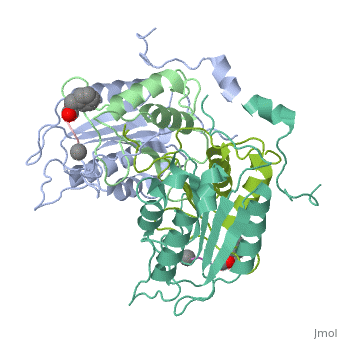2h4w
From Proteopedia
(Difference between revisions)
| Line 1: | Line 1: | ||
| - | + | ==Crystal structure of human caspase-1 (Glu390->Asp) in complex with 3-[2-(2-benzyloxycarbonylamino-3-methyl-butyrylamino)-propionylamino]-4-oxo-pentanoic acid (z-VAD-FMK)== | |
| - | + | <StructureSection load='2h4w' size='340' side='right' caption='[[2h4w]], [[Resolution|resolution]] 2.00Å' scene=''> | |
| - | + | == Structural highlights == | |
| + | <table><tr><td colspan='2'>[[2h4w]] is a 3 chain structure with sequence from [http://en.wikipedia.org/wiki/Homo_sapiens Homo sapiens]. Full crystallographic information is available from [http://oca.weizmann.ac.il/oca-bin/ocashort?id=2H4W OCA]. For a <b>guided tour on the structure components</b> use [http://oca.weizmann.ac.il/oca-docs/fgij/fg.htm?mol=2H4W FirstGlance]. <br> | ||
| + | </td></tr><tr><td class="sblockLbl"><b>[[Non-Standard_Residue|NonStd Res:]]</b></td><td class="sblockDat"><scene name='pdbligand=CF0:FLUOROMETHANE'>CF0</scene>, <scene name='pdbligand=PHQ:BENZYL+CHLOROCARBONATE'>PHQ</scene></td></tr> | ||
| + | <tr><td class="sblockLbl"><b>[[Related_structure|Related:]]</b></td><td class="sblockDat">[[2fqv|2fqv]], [[1sc3|1sc3]], [[2fqq|2fqq]], [[2fqr|2fqr]], [[2fqs|2fqs]], [[2fqu|2fqu]], [[2h48|2h48]], [[2h44|2h44]], [[2h51|2h51]], [[2h54|2h54]]</td></tr> | ||
| + | <tr><td class="sblockLbl"><b>[[Gene|Gene:]]</b></td><td class="sblockDat">CASP1, IL1BC, IL1BCE ([http://www.ncbi.nlm.nih.gov/Taxonomy/Browser/wwwtax.cgi?mode=Info&srchmode=5&id=9606 Homo sapiens])</td></tr> | ||
| + | <tr><td class="sblockLbl"><b>Activity:</b></td><td class="sblockDat"><span class='plainlinks'>[http://en.wikipedia.org/wiki/Caspase-1 Caspase-1], with EC number [http://www.brenda-enzymes.info/php/result_flat.php4?ecno=3.4.22.36 3.4.22.36] </span></td></tr> | ||
| + | <tr><td class="sblockLbl"><b>Resources:</b></td><td class="sblockDat"><span class='plainlinks'>[http://oca.weizmann.ac.il/oca-docs/fgij/fg.htm?mol=2h4w FirstGlance], [http://oca.weizmann.ac.il/oca-bin/ocaids?id=2h4w OCA], [http://www.rcsb.org/pdb/explore.do?structureId=2h4w RCSB], [http://www.ebi.ac.uk/pdbsum/2h4w PDBsum]</span></td></tr> | ||
| + | <table> | ||
| + | == Evolutionary Conservation == | ||
| + | [[Image:Consurf_key_small.gif|200px|right]] | ||
| + | Check<jmol> | ||
| + | <jmolCheckbox> | ||
| + | <scriptWhenChecked>select protein; define ~consurf_to_do selected; consurf_initial_scene = true; script "/wiki/ConSurf/h4/2h4w_consurf.spt"</scriptWhenChecked> | ||
| + | <scriptWhenUnchecked>script /wiki/extensions/Proteopedia/spt/initialview01.spt</scriptWhenUnchecked> | ||
| + | <text>to colour the structure by Evolutionary Conservation</text> | ||
| + | </jmolCheckbox> | ||
| + | </jmol>, as determined by [http://consurfdb.tau.ac.il/ ConSurfDB]. You may read the [[Conservation%2C_Evolutionary|explanation]] of the method and the full data available from [http://bental.tau.ac.il/new_ConSurfDB/chain_selection.php?pdb_ID=2ata ConSurf]. | ||
| + | <div style="clear:both"></div> | ||
| + | <div style="background-color:#fffaf0;"> | ||
| + | == Publication Abstract from PubMed == | ||
| + | Structural studies of caspase-1 reveal that the dimeric thiol protease can exist in two states: in an on-state, when the active site is occupied, or in an off-state, when the active site is empty or when the enzyme is bound by a synthetic allosteric ligand at the dimer interface approximately 15 A from the active site. A network of 21 hydrogen bonds from nine side chains connecting the active and allosteric sites change partners when going between the on-state and the off-state. Alanine-scanning mutagenesis of these nine side chains shows that only two of them-Arg286 and Glu390, which form a salt bridge-have major effects, causing 100- to 200-fold reductions in catalytic efficiency (k(cat)/K(m)). Two neighbors, Ser332 and Ser339, have minor effects, causing 4- to 7-fold reductions. A more detailed mutational analysis reveals that the enzyme is especially sensitive to substitutions of the salt bridge: even a homologous R286K substitution causes a 150-fold reduction in k(cat)/K(m). X-ray crystal structures of these variants suggest the importance of both the salt bridge interaction and the coordination of solvent water molecules near the allosteric binding pocket. Thus, only a small subset of side chains from the larger hydrogen bonding network is critical for activity. These form a contiguous set of interactions that run from one active site through the allosteric site at the dimer interface and onto the second active site. This subset constitutes a functional allosteric circuit or "hot wire" that promotes site-to-site coupling. | ||
| - | + | An allosteric circuit in caspase-1.,Datta D, Scheer JM, Romanowski MJ, Wells JA J Mol Biol. 2008 Sep 19;381(5):1157-67. Epub 2008 Jun 20. PMID:18590738<ref>PMID:18590738</ref> | |
| - | + | ||
| + | From MEDLINE®/PubMed®, a database of the U.S. National Library of Medicine.<br> | ||
| + | </div> | ||
==See Also== | ==See Also== | ||
*[[Caspase|Caspase]] | *[[Caspase|Caspase]] | ||
*[[Human Caspase-1|Human Caspase-1]] | *[[Human Caspase-1|Human Caspase-1]] | ||
| - | + | == References == | |
| - | == | + | <references/> |
| - | < | + | __TOC__ |
| + | </StructureSection> | ||
[[Category: Caspase-1]] | [[Category: Caspase-1]] | ||
[[Category: Homo sapiens]] | [[Category: Homo sapiens]] | ||
Revision as of 07:43, 30 September 2014
Crystal structure of human caspase-1 (Glu390->Asp) in complex with 3-[2-(2-benzyloxycarbonylamino-3-methyl-butyrylamino)-propionylamino]-4-oxo-pentanoic acid (z-VAD-FMK)
| |||||||||||


